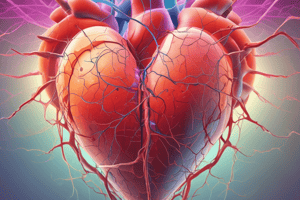Podcast
Questions and Answers
What is the primary function of perfusion?
What is the primary function of perfusion?
Which of the following is NOT a key component of perfusion?
Which of the following is NOT a key component of perfusion?
What happens to perfusion if cardiac output is reduced?
What happens to perfusion if cardiac output is reduced?
How does hypertension affect perfusion?
How does hypertension affect perfusion?
Signup and view all the answers
Why is oxygenation so critical for perfusion?
Why is oxygenation so critical for perfusion?
Signup and view all the answers
What is a common characteristic of shock?
What is a common characteristic of shock?
Signup and view all the answers
Which of these is a possible consequence of poor perfusion?
Which of these is a possible consequence of poor perfusion?
Signup and view all the answers
How does atherosclerosis affect perfusion?
How does atherosclerosis affect perfusion?
Signup and view all the answers
What is the classic symptom of Peripheral Artery Disease (PAD)?
What is the classic symptom of Peripheral Artery Disease (PAD)?
Signup and view all the answers
What type of shock is caused by severe infection?
What type of shock is caused by severe infection?
Signup and view all the answers
Which of the following is NOT a nursing intervention for impaired perfusion?
Which of the following is NOT a nursing intervention for impaired perfusion?
Signup and view all the answers
Which of the following is a sign of poor perfusion?
Which of the following is a sign of poor perfusion?
Signup and view all the answers
What medication might be used to open up blood vessels in a patient with impaired perfusion?
What medication might be used to open up blood vessels in a patient with impaired perfusion?
Signup and view all the answers
What is the main factor that affects perfusion?
What is the main factor that affects perfusion?
Signup and view all the answers
Which of the following is a compensatory mechanism the body uses when perfusion is impaired?
Which of the following is a compensatory mechanism the body uses when perfusion is impaired?
Signup and view all the answers
Which of the following accurately describes perfusion?
Which of the following accurately describes perfusion?
Signup and view all the answers
Flashcards
Perfusion
Perfusion
The process of delivering oxygenated blood to body tissues.
Cardiac Output (CO)
Cardiac Output (CO)
The amount of blood the heart pumps per minute.
Blood Pressure (BP)
Blood Pressure (BP)
The force of blood against vessel walls, influencing flow.
Vascular Resistance
Vascular Resistance
Signup and view all the flashcards
Oxygenation
Oxygenation
Signup and view all the flashcards
Shock
Shock
Signup and view all the flashcards
Hypotension
Hypotension
Signup and view all the flashcards
Hypertension
Hypertension
Signup and view all the flashcards
Cardiogenic Shock
Cardiogenic Shock
Signup and view all the flashcards
Hypovolemic Shock
Hypovolemic Shock
Signup and view all the flashcards
Septic Shock
Septic Shock
Signup and view all the flashcards
Heart Failure Symptoms
Heart Failure Symptoms
Signup and view all the flashcards
Peripheral Artery Disease (PAD)
Peripheral Artery Disease (PAD)
Signup and view all the flashcards
Capillary Refill Assessment
Capillary Refill Assessment
Signup and view all the flashcards
Nursing Interventions for Perfusion
Nursing Interventions for Perfusion
Signup and view all the flashcards
Compensatory Mechanisms
Compensatory Mechanisms
Signup and view all the flashcards
Study Notes
Perfusion Overview
- Perfusion is the delivery of oxygenated blood to tissues.
- Inadequate perfusion leads to organ and tissue dysfunction.
- Perfusion involves the entire circulatory system (arteries, veins, capillaries).
Key Components of Perfusion
- Cardiac Output (CO): The amount of blood pumped by the heart per minute. Low CO impairs perfusion (e.g., heart failure, shock, arrhythmias).
- Blood Pressure (BP): The driving force of blood flow. Low BP (hypotension) limits tissue oxygenation; high BP (hypertension) damages vessels over time.
- Vascular Resistance: The difficulty blood encounters flowing through vessels. Narrowed or blocked arteries hinder perfusion (e.g., atherosclerosis).
- Oxygenation: Adequate oxygen levels in the blood are critical for perfusion. Poor gas exchange in the lungs reduces oxygen availability.
Conditions Related to Impaired Perfusion
- Shock: A life-threatening condition where blood flow to tissues is severely compromised, leading to organ damage. Types include cardiogenic, hypovolemic, and septic shock.
- Heart Failure: The heart's inability to pump enough blood, causing fluid buildup in the lungs (left-sided) or body (right-sided). Symptoms include shortness of breath, edema, and fatigue.
- Peripheral Artery Disease (PAD): Narrowed arteries reduce blood flow to the limbs, causing intermittent claudication (pain in the limbs during exercise that resolves with rest).
Nursing Interventions for Impaired Perfusion
- Monitor vital signs: Includes blood pressure, heart rate, and oxygen saturation to assess perfusion status.
- Assess capillary refill and skin color: Slow capillary refill or pale/cool skin indicates poor perfusion.
- Administer medications: Vasodilators (e.g., nitroglycerin) widen blood vessels; beta-blockers regulate heart rate; diuretics remove excess fluid.
- Promote mobility and positioning: Elevating legs and preventing pressure ulcers support venous return and minimize complications in immobile patients.
- Administer supplemental oxygen: If oxygen levels are low, supplemental oxygen improves perfusion.
Key Takeaways & Exam Tips
- Perfusion is vital oxygenated blood circulation to tissues.
- Cardiac output, blood pressure, vascular resistance, and oxygenation are crucial for proper perfusion.
- Conditions like shock, heart failure, and PAD result from compromised perfusion.
- Nurses use assessments (vital signs, capillary refill) and interventions to manage perfusion issues.
Studying That Suits You
Use AI to generate personalized quizzes and flashcards to suit your learning preferences.
Description
This quiz explores the essential concepts of perfusion, focusing on its components such as cardiac output, blood pressure, and vascular resistance. Additionally, it covers conditions that may lead to impaired perfusion and their impact on organ function. Enhance your understanding of how effective blood flow is vital for maintaining tissue health.




